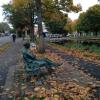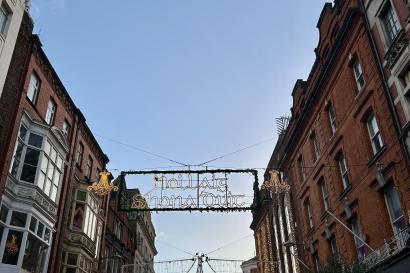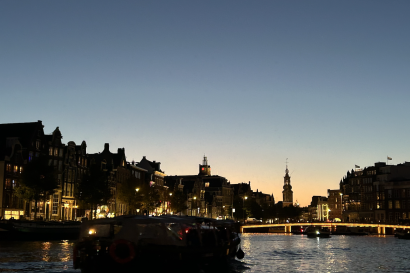If you start at St. Stephen’s Green and go down Grafton Street, past the Decent Cigar Emporium and T.G.I. Friday’s, past the street performers and Carroll’s Irish Gifts, you’ll end up at the front gates of Trinity College. There’s lot of construction around there at the moment, so much of the sidewalk around the entrance is blocked off, but nonetheless, all along the pedestrian walkway, there are signs pointing toward what is probably the school’s most precious possession: the Book of Kells.
I’ve seen those signs countless times during my two months in Dublin and I’d been assured of the sheer specialness, the beauty, of the Book, long before I ever set foot in the city, by the art history professor who taught the section on medieval art in the introductory course I took last fall, by the college chaplain who stared me right in the eyes when he told me, “You have to go see it.”
But I’d also heard about the Book of Kells from a taxi driver in County Clare who, after speaking of all the wonders of Ireland, like the Cliffs of Moher and the Giant’s Causeway and the town of Dingle, said, “And then there’s Dublin, where they’ve got the Book of Kells, and you walk into the room and everyone’s staring stupidly into a glass case at two pages of a book.”
Maybe it’s incorrect to weigh his words equally with the attestations of art scholars and Christian chaplains and the many, many visitors who follow those signs outside Trinity into the Old Library, where the Book is kept every day, every day, every year. Still, I have to admit that there is at least an element of truth to what the taxi driver said: The Book of Kells may be twelve hundred years old, but it’s still just a book. Moreover, it’s a book that tells a story you can find in millions, perhaps billions, of other places around the world. The Bible has been in print for thousands of years. You can read the Gospels of Mark, Matthew, Luke, and John – the exact texts reproduced in the Book of Kells – if you type a few words into the Google search drive. The Book of Kells doesn’t even present a readable version to the story it tells, unless you happen to know Latin and be very good at making sense of medieval handwriting.
But if I could have stayed for hours in the room where that glass case and its contents were kept, I would have. (Unfortunately, the exhibit was closing soon. Also, a camp-out would have likely annoyed the two friends who I had come with, especially as I already have rather a reputation for slowness. Sorry, Grace and Lisa.) I wanted to take it out of its case, to touch the vellum of its pages and feel if they were soft, might have even blasphemed against my own vegetarianism by thinking that the deaths of all those cows were worth it, since they enabled the production of this manuscript by Irish monks in ninth century Britain or Ireland. The Book of Kells is, without doubt, one of the best things I have ever seen.
A large part of the reason I felt this way, I think, is because the Book of Kells is, to put it very simply, just beautiful. It includes illustrated carpet pages, which are full of swirling Celtic designs and animal imagery; portraits of all the Gospel writers, which herald the beginnings of each section (which are now bound in four separate volumes, so that the Book of Kells is actually the Books of Kells); and pages of prose ornamented with the occasional illustrated letters, so that the ‘D’ of the word “Dicebat” – meaning “he said” – is sometimes rendered into the picture of a dragon, mouth open wide, a literal image of what it means to speak, to say.
The pages I saw during my visit were from the Gospel of Mark and the Gospel of Matthew. (The other two volumes are currently in a safe housed elsewhere at Trinity.) The pages from the Gospel of Matthew narrated an episode in which Jesus confronted the Pharisees – something I could discern due to the helpful placard next to the Book that translated its content. But the pages from Matthew’s Gospel entranced me less than the lines in its companion.
Both of the pages from the Gospel of Mark spoke of the crucifixion. Verses 15:20-24 were on the left-hand page, with a few colored illustrations on various letters. The right-hand page was wholly taken up by Verse 15:25, “erat autem hora tercia et cruifixerunt eum,” that is, “It was the third hour when they crucified him.”
The sentence that speaks of this scene, that articulates the very moment of Jesus’s crucifixion, is rendered in words, but they are words as I’ve never before seen them, words that are art, too. The capital ‘H’ of “Hora” takes up the entire page and the last three letters of “tercia” are very, very small, snuck into the side of the page so as to just fit in the space at the edge of the page. Indeed, the big block letters are placed so oddly on the vellum that it’s hard to determine how they relate to one another. Again, I can only make sense of it at all by reading the placard and looking, long and hard.
Even then, in the way I couldn’t translate the Cliffs of Moher into sentences, I can’t quite get down here what the Books of Kells looked like. But maybe the very fact that I can’t articulate the Book of Kells except in quotation bespeaks of the way it is a book that is more than a book.
Is it blasphemy for me to say such a thing, as a writer, as a student of literature, when I stand before the Book? An English professor I had once used to say that it drove him nuts when people said they did not have words to express what they had seen. “All I want to ask them,” he said, speaking in the curt, precise way in which he always employed language, “was, ‘Have you tried all of them?’”
Is it blasphemy, too, for me to say such a thing of the Book of Kells, a text that literally includes, in the Gospel of John, the declaration that, “In the beginning was the Word, and the Word was with God, and the Word was God”? After all, the Book of Kells is a Christian text, and as William J. Diebold writes in Word and Image: An Introduction to Medieval Art, the Word is of great importance to Christianity, perhaps even of the utmost importance. It’s why Irish monks were engaged in the copying and recopying of Biblical verse in the first place, why they made the Book of Kells at all.
When Christianity was brought to Ireland, a major shift began in the religion and culture of the island. A literate, monotheistic culture superimposed (but did not entirely eradicate) a polytheistic, oral Celtic one. As Mary Condren writes in The Serpent and the Goddess, when the monotheistic, masculine God replaced the old bisexual gods and goddesses of polytheism, Creation became a verbal act, an act of will, rather than an act that was corporal and sexual and within the domain of the feminine. In the new Christian religion, like the Jewish religion before it, the “Will of God” could be interpreted, written, and controlled by the predominately male priests and prophets. God the Father – and so also those who both led and subscribed to His order -- would no longer be, in Condren’s words, “at the mercy of passion, the caprices of womanhood, or mere sexuality.” Jesus was born, after all, through Immaculate Conception. Christianity is at least partly, perhaps, an attempt to escape the womb, to escape the leak of amniotic liquid, the flow of red blood, to exit forever the body and the power of the woman, the female, the mother.
So is saying the Book of Kells is beyond words to miss the point of exact what it literally says? I don’t think so, in the same way that I don’t think that it is truly a blasphemy for me, as a writer (or, at least, as an aspiring one), to confess myself to be without words before it. After all, I am not just a writer. I am also a daughter – in fact, the daughter of a mother who is also a sign language interpreter, and thus, the trafficker of a language that challenges the very notion that we all think literarily and linearly, that we all think in words.
Likewise, if Christianity is a philosophy that gives credence to patriarchy, that gives credence to misogyny, it is also a religion that has a deep element of mysticism, of corporality and pain. Jesus was born through Immaculate Conception, but the small band of men that stand atop the Church hierarchy hasn’t been able to shake the pull of loyalty that his mother, Mary, has for many of its adherents. Christ may have been born without the “stain” of sin or sex, but he also died in – and for – body and blood.
This is something I think those Irish monks of the ninth century knew. Surely there was a material, corporal, even painful element to their very act of Creation that must have bespoke to them the futility of believing that they could ever eradicate the flesh with the Word. Indeed, it was cow flesh that sat before them, the very plane upon which they spilled their ink. The physical nature of their act is very clear in the poem, “Marginalia,” in which its author, Billy Collins, writes:
Even Irish monks in their cold scriptoria
jotted along the borders of the Gospels
brief asides about the pains of copying,
a bird singing near their window,
or the sunlight that illuminated their page–
anonymous men catching a ride into the future
on a vessel more lasting than themselves.
The Word of God they record becomes enveloped in the materiality of existence: the bird on the window sill, the play of shadow across a page, the ache in their fingers. We cannot escape the sheer physicality of our lives, because its exactly the corporal nature of the world, the world we enter through the wombs of our mothers, that renders it its meaningful, that gives it a meaning at which all the alphabets in the world can only, in the end, gesture.
Books, I think, are always more than books – or at least, more than mere vessels of information. They are also vessels. And this is why, on the crowded streets of the Temple Bar Book Market on the day after I see the Book of Kells, I buy the more worn copy of Joyce’s A Portrait of the Artist as a Young Man, the one with yellowed pages and slightly awkward, annotations, and not the unmarked, newer reprint.
*This essay was informed by Mary Condren’s The Serpent and the Goddess (Dublin: New Island Books, 2002 [1989]) and William J. Diebold’s Word and Image: An Introduction to Early Medieval Art (Boulder, Co.: Westview, 2000), both of which are also cited in the above text. The quote from the Gospel of John is from the version cited in Word and Image.

Chelsea Thomeer
I'm a rising junior at Williams College majoring in English and political science. I love reading and running, Jane Austen and J.K. Rowling, pumpkin bread and pretzels, The Grapes of Wrath and green tea. I'm spending a semester in Ireland to study Irish literature and to work on my own writing.







